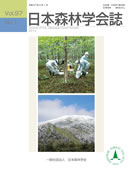Volume 97, Issue 1
Displaying 1-12 of 12 articles from this issue
- |<
- <
- 1
- >
- >|
Articles
-
2015Volume 97Issue 1 Pages 1-9
Published: February 01, 2015
Released on J-STAGE: April 07, 2015
Download PDF (510K) -
2015Volume 97Issue 1 Pages 10-18
Published: February 01, 2015
Released on J-STAGE: April 07, 2015
Download PDF (674K) -
2015Volume 97Issue 1 Pages 19-24
Published: February 01, 2015
Released on J-STAGE: April 07, 2015
Download PDF (1049K)
Short Communication
-
2015Volume 97Issue 1 Pages 25-29
Published: February 01, 2015
Released on J-STAGE: April 07, 2015
Download PDF (711K)
Special Issure " Radioactive Contamination in the Forest due to the Fukushima Daiichi Nuclear Power Plant Accident "
Preface
-
2015Volume 97Issue 1 Pages 30-32
Published: February 01, 2015
Released on J-STAGE: April 07, 2015
Download PDF (320K)
Articles
-
2015Volume 97Issue 1 Pages 33-43
Published: February 01, 2015
Released on J-STAGE: April 07, 2015
Download PDF (1095K) -
2015Volume 97Issue 1 Pages 44-50
Published: February 01, 2015
Released on J-STAGE: April 07, 2015
Download PDF (1615K) -
2014Volume 97Issue 1 Pages 51-56
Published: February 01, 2014
Released on J-STAGE: April 07, 2015
Download PDF (2051K) -
2015Volume 97Issue 1 Pages 57-62
Published: February 01, 2015
Released on J-STAGE: April 07, 2015
Download PDF (858K) -
2015Volume 97Issue 1 Pages 63-69
Published: February 01, 2015
Released on J-STAGE: April 07, 2015
Download PDF (1002K) -
2015Volume 97Issue 1 Pages 70-74
Published: February 01, 2015
Released on J-STAGE: April 07, 2015
Download PDF (463K)
Review
-
2015Volume 97Issue 1 Pages 75-80
Published: February 01, 2015
Released on J-STAGE: April 07, 2015
Download PDF (458K)
- |<
- <
- 1
- >
- >|
